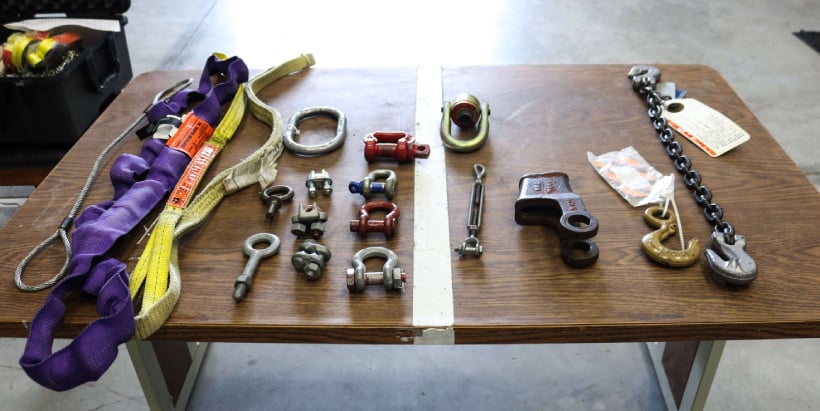
New Changes to ASME B30.5 ‘Mobile and Locomotive Cranes’
Published December 17th, 2021, the revised ASME B30.5 prescribes written and practical examinations for an employer to qualify their riggers.
At least one qualified rigger must be present on the job site when a mobile crane is involved. Importantly, this is regardless of industry, meaning the ruling applies as much to the tree-trimming industry as it does to major construction outfits.
Crucially, however, there is a difference between certification and qualification as OSHA and ANSI/ASME define it.
Understanding this difference is critical for every employer as they look to train their riggers to the new standard. In this article we will define the difference between qualified vs certified, so you can decide which training is the best for you.
What is Rigger Qualification?
Per the new ASME B30.5 standard, a rigger can only be qualified when they take a written and practical examination that test
- Selection and use of applicable hardware
- Applications of standard hitches
- Estimation of load weight, center of gravity, angle and load movement
- Inspection of equipment
However, passing these tests does not qualify the rigger.
Instead, ‘qualified’ is a designation given to the rigger by the employer, based on proof of successful completion of training and examinations.
What is Rigger Certification?
A rigger is certified when they pass a written and practical exam administered by an accredited certifying agency.
The newly titled ANAB – the ANSI National Accreditation Board – currently accredits only the CCO to deliver rigger certifications.
The CCO offer three levels of rigger certification:
What are the differences between Rigger Certification and Rigger Qualification?
Rigger certification is achieved by taking a written and practical examination from an accredited agency such as the CCO.
Rigger qualification is an employer designation based on proof of successful completion of a written and practical exam that can be administered by anybody, but that includes certain competencies established in the new ANSI B30.5 standard.
Some certifications may also meet the requirements for an employer to designate as qualified, but the reverse is not true.
Specifically, the core competencies established by ANSI B30.5 for the qualification of a rigger are met by the CCO Rigger II program.
This is currently the only accredited certification that meets the requirements of qualification for riggers.
Conversely, certain training providers such as CICB have authored their own, in-house training programs that meet the requirements for an employer to designate a trainee as a qualified rigger, but are not accredited by an accrediting agency and therefore do not meet the definition of certification.
Why is Rigger Qualification Important?
Prior to the publication of the 2021 ASME B30.5 standard, a qualified rigger was only required during assembly/disassembly or when personnel were operating in the fall zone.
Now, however, a qualified rigger must be present in any situation where a mobile crane over 2000lbs capacity is being used.
It is vital to note in addition that this standard applies across every industry.
This includes everything from boom trucks working on signs or trees, to mechanic’s service trucks making equipment repair.
The standard is not limited to large cranes on construction sites.
Why is Rigger Certification Important?
There is no OSHA or ANSI/ASME requirement for rigger certification.
However, because of the credibility of CCO and the industry’s need to guarantee a minimum level of competency, CCO Rigger 1 or 2 certification is often a pre-requisite on contract bids.
Since everyone takes the same test, it is a good yardstick by which to assess rigger ability.
Exploring Your Options for Rigger Training,
At this point it may be helpful to break down your options as they relate to your riggers.
- Training – at an absolute minimum, your riggers should be trained. While much of their training will happen on the job, consider enrolling them in a training program that covers rigger fundamentals.
- Certification – CCO is considered the gold standard in crane and rigging certification. And, since the only other accredited certifying agency in the space – NCCER – is not accredited for its rigging programs, CCO’s Rigger certifications are the only real choice for employers who wish to go this route.
- Qualification – At least one member of your on-site rigger team must be qualified. To be able to designate them as ‘qualified’, you should first put them through a written and practical examination. CICB has authored rigger training specifically geared to meet the need for qualified riggers. Similarly, CCO Rigger II, a five-day program that includes four days of preparatory training with CICB, and a fifth day of examinations, would also work as a basis for qualification.
Making the choice between rigger certification and rigger qualification may involve asking some or all of the following questions
- How many teams of riggers do you have?
- What are the bid/contractor requirements?
- To what level have your riggers already been trained?
- How experienced are your personnel?
- How much time is available to remove your riggers from the job site?
- What budget are you working with?
- Which industry will your riggers be working in?
- What are your preferences for refresher classes?
- How important is name recognition?
Safer Rigging Practices
The introduction of the 2021 ASME B30.5 standard is a welcome step towards safer rigging practices and mobile crane use. Dr. Wiethorn of International Crane & Construction Safety Solutions has found that fully 16.8% of crane accidents in construction are the result of faulty rigging practices. The new requirement for qualified riggers is therefore a valuable component in ensuring the safety of picks.
So whether you opt to train, qualify or certify your riggers, the net result is a safer industry for all of us.






